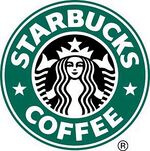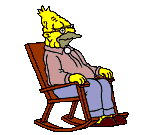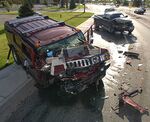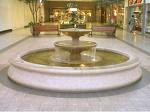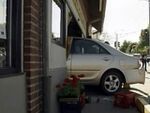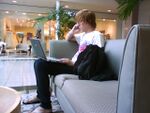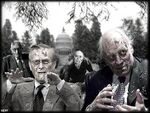Shopping malls
“'I wish they taught shopping in school.'”
Shopping malls are America's first and premiere choice for shopping. Shoppers can buy anything at the mall, from harmonicas to the original cast of M.A.S.H., provided the item exists, and even if it doesn't. Shopping malls have 1 or 2 or eleventeen anchor stores[1] and numerous small in-line stores. Accept nothing less. Most malls contain a Macy's, Starbucks, Pottery Barn, Gap, Needless Markup, Starbucks, the 4 hour line for a seat in the Rainforest Cafe, American Eagle Outfitters, Abercrombie & Fitch, Banana Republic, Hot Topic (located next door to the Disney Store), Starbucks, Gap, Build-A-Bear Workshop, Starbucks, The Ganja House, Baby Gap, Victoria's Secret, The Little Shop of Horrors, Gap, Nordstrom, a multiplex, and a Starbucks conveniently located on every corner.
If you are planning an excursion to your local mall you should take comfortable shoes, a first aid kit, a sack of potatoes, your neighbor's kitchen sink, and a guide dog to find your way out. Keep your eye on the guide dog at all times or it will slip away, find a mate, have puppies, and set up housekeeping in the Build-A-Bear Workshop.
Origin[edit]
The Zarathustra bible of 8000 B.C. reveals the origin of the shopping mall.
“It was under the third full moon that Baal decided to punish humanity. His curse was called... the shopping mall. Baal himself said 'Those who like to walk slow shall be in the way of those who like to walk fast. Women shall bring their screaming children and ignore them completely.'”
Shopping malls through the ages[edit]
Malls have existed throughout human history and may predate life on Earth.
Cave paintings show caveman malls supplied the fledgling human population with caves, spears, bearskins, cave paintings, and Starbucks drinks. Several cave people are depicted asking sales clerks for fire, but as fire wasn't invented yet they had to settle for those fake fires made with tissue paper and air pumps.
Later, Vikings malls sold ships, rowers to row the ships, chains to keep the rowers chained, torches, ale, skull caps to drink the ale from, meat (raw and cooked), Starbucks drinks, those cool horned helmets and Tickle Me Elmos.
Malls in the Middle Ages sold armies, plagues, famines, cannons, suits of armor, village idiots, Starbucks drinks, flying buttresses and hula hoops.
Malls in colonial America sold Puritan clothing, stocks, kettles, cows, indentured servants, chimneys, Starbucks drinks, spinning wheels, werewolves, therewolves and Soylent Green.
Witches 'R Us was the most popular store in 1692 Salem, Mass. Items just flew off the shelves. It did a bang up business selling broomsticks, eyes of newt, toes of bats, do-it-yourself voodoo kits, and specters, but the best selling item by far was rare copies of Dale Carnegie's book How to Hex Friends and Curse People.
Pioneer malls sold covered wagons, horses to pull the wagons and prepare the family meals, plows, seeds, butter churns, blizzards, grasshopper plagues, cowboys, cowboy hats, Starbucks drinks, gold fever and Frisbees.
Malls nearly became extinct during the Great Depression of the 1930s. They had to stop selling Starbucks drinks and were reduced to selling dried apples and Prozac. They couldn't afford employees, so they relied on free labor from elderly people. This meant shoppers had to endure long, rambling stories about how malls, life, and everything was better and simultaneously harder in THEIR day and young people today don't appreciate anything. The most oft-told stories concerned how they had to walk 10 miles to school and back in knee-high snow all year round, uphill both ways and that was the way we liked it!
In WWII malls sold war bonds, bobby sox, automobiles with running boards, victory gardens, Tupperware, Starbucks drinks, ranch style houses and ready made bowling alleys.
Dangers of today's malls[edit]
Malls have become the preferred venue for the new phenomenon of power walkers, both individually and in groups. Power walkers should be avoided, as they are known to trample anything that gets in the way of their path to physical fitness, including small children, babies in strollers, dingoes, Hummers, Hare Krishnas, tour buses, and the population of downtown Tibet.
A danger frequently encountered in today's shopping mall is survey takers. Survey takers pursue their prey relentlessly and will spend years following you around asking questions about your political views and what brand of shampoo you use and why. The only known method of escape is invoking the name of Anne Coulter. The invocation will cause creepy violin music to play, the sky to briefly darken, lightning to flash, and thunder to crash, in that order, and should only be used in emergencies.
Another common danger is clerks at the cosmetic counter giving free samples. Do not make eye contact with them. These clerks are persistent and will not give up until their chosen victim looks like Krusty the Klown and buys every cosmetic in the department just to escape. Once you realize you have been chosen the clerk can be diverted by pointing over their shoulder and saying "Look! It's Paris Hilton!" When they turn their head to look, run and lose yourself in the crowd. If Paris Hilton really is there, run faster.
The biggest danger by far is perfume sprayers. This clan originally splintered off from the Borg and there is no known way to escape this menace. Resistance is futile. No matter how far you run, they will pop up, tackle you to the floor and douse you in smelly perfume. If you are targeted by a perfume sprayer, give in and resign yourself to your fate. When it's all over and they have moved on to their next victim, pick yourself up and move on with your life. Treating yourself to a drink at Starbucks is a good way to start.
The wishing well[edit]
Many malls have large elevated ponds equipped with fountains known as wishing wells. People throw loose change in them to appease the mall gods, lest they unleash a plague of Amway salesmen. If you don't have any loose change, items of equal or lesser value may be thrown instead. Throwing children in is discouraged but if they insist, go for it.
Mall amenities[edit]
Malls of today include many amenities to make your shopping experience more pleasant. Parents can drop their kids off in the daycare center and shop secure in the knowledge that if their perfect offspring are eating paste, shoving blocks up their noses or some other kids noses, or flushing Barbie down the toilet, it's somebody else's problem this time.
Food courts have restaurants selling every kind of food imaginable, from McDonald's to Thai, provided it's way overpriced, can be mass produced, and tastes like cardboard. Food courts are usually located on the second floor and feature hundreds of seats, which precludes drive through service although this hasn't stopped some people from trying.
Restrooms feature many technological wonders such as self-flushing toilets, automatic faucets, and hand dryers. Unfortunately, no technology exists to address empty toilet paper holders, empty soap dispensers, and water that's either too hot or too cold, which people sometimes sue the entire mall company for. Restrooms are usually located in some out of the way spot that's nearly impossible to find, because restrooms are considered unsightly.
Other amenities include ATMs every 20 feet, photo booths, vending machines that keeps eating away money, strollers for parents too paranoid/snobby to use the daycare center, a customer service center where you can complain about that snippy clerk who didn't believe you're a size 6 and refused to accept your maxed out credit cards, and lounges where you can sit and rest your aching feet. Mall management discourages the use of the lounges by piping in Muzak. Shoppers driven into homicidal rages by the Muzak are collected by mall security and taken to a room where they will receive treatment and emerge as perfume sprayers.
Mall subcultures[edit]
Malls are also a popular place for recreation. At any time of the day you can observe people from all walks of life shopping, drinking Starbucks drinks, and milling around.
Women typically use malls for buying shoes and other pricey items they can't afford. Afterwards, they meet with friends to eat in the food court, where they show off their purchases and whine about how they shouldn't have, but just couldn't help themselves. Then they engage in gossip and making scathingly catty remarks about other women.
Males are genetically predisposed to hate shopping unless it has something to do with cars. If they are forced to accompany a relative, wife, girlfriend or significant other to the mall, they tend to congregate in electronics, sports, hardware and automotive centers, where they talk about cars, sports and what size drill bits are the best. If they are lucky enough to be at a mall that has an auto repair shop, they can watch the mechanics work and provide much needed advice and commentary on how they could do the job better. If there are enough men they can run pools on which mechanic will be the first to chase them out with a wrench, and what kind of wrench it will be.
Teenagers roam the mall in herds, in groups segregated by gender, but never moving too far away from each other.
- Teen girls typically spend their time giggling and buying trendy clothes and accessories, then moaning and groaning about how their parents are going to kill them, but they just have to have it. They can usually be seen in the vicinity of Claire's jewelry and accessory boutiques, their number one choice for shoplifting, and hanging around the food court trying to get the attention of teen boys while pretending not to notice them.
- Teen boys share the adult males' loathing for shopping, but happily find many other fun things to do at the mall. Number one on the list is dropping food, such as opened ketchup and mustard packets from the food court, over the balcony onto the passersby below until mall security kicks them out. Other popular items for dropping are gum, smoothies, spitballs, live frogs, snakes, and the Stay Puft Marshmallow man. When they're not on the balcony, they can be found hanging around the food court, roughhousing, and eating – teenage boys can eat a metric ton of food in one sitting and still be hungry. They will also try to get the attention of teen girls while pretending not to notice them.
Senior citizens spend their time sitting on benches complaining about the teenagers, all the milling around, how the world is going to hell in a handbasket and why the hell doesn't anybody sell Black Jack gum anymore? Reminiscing about the good old days of ration books, big band music, and cars with running boards is another favorite activity.
The parking garage[edit]
Mall parking garages are byzantine structures populated by people wandering around aimlessly, trying to remember where they parked. It is rumored some people were there so long they hooked up, started families, brought about a new subculture of youth that have never been touched by natural light or breathed non-ventilated air, and that these youths eventually spawned a race of brain eating zombies called Republicans.
If you park in the garage you should leave a trail of breadcrumbs so you can find your way back. Of course, those breadcrumbs will be eaten by birds, or possibly Republicans, so you should use something no one will eat, like granola.
